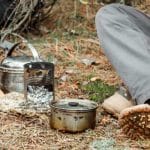As someone who has spent countless hours exploring the great outdoors and honing my survival skills, I’ve come to appreciate the right gear’s value.
Traditional bushcraft gear, in particular, is a collection of time-tested tools and equipment that have been used for centuries by indigenous people and outdoorsmen alike. Whether you’re building a shelter, starting a fire, or preparing a meal, having the right gear can mean the difference between success and failure in the wilderness.
Top 8 Picks For Your Traditional Bushcraft Kit
Needless to say, the basics are clear, but we still need to set them apart:
1. Blade
A high-quality blade can make these tasks more efficient and easier to perform, which is especially important in a survival situation where time and energy are valuable resources. Of course, your blade can be an axe or bushcraft machete too, not just a bushcraft knife.
2. Fire kit
A traditional fire kit typically includes several components, such as a fire starter, kindling, and fuel. The firestarter can take many forms, from flint and steel to a magnifying glass, and it’s used to ignite the kindling, which is small, dry twigs or other materials that catch fire easily.
3. Clothes
Clothes are often overlooked when it comes to bushcraft gear, but they should not be underestimated. Traditional bushcraft clothing is designed to keep you comfortable and safe in a variety of environments and conditions.
4. Gloves
Gloves have long been a part of bushcraft gear, providing protection from the elements, as well as providing comfort and dexterity. For centuries, gloves have been used to protect hands from cold weather and sharp objects.
5. Utensils
Whether it’s a spoon, fork, or knife, these tools are essential for any outdoor meal. Not only do they make eating easier, but they can also be used to prepare food such as cutting vegetables or slicing meat.
6. Containers
They are used to store food, water, and other supplies. Containers come in various shapes and sizes depending on the type of activity you plan on doing. From gourds and bottles to bushcraft backpacks and buckets, containers can be used for a variety of purposes when it comes to bushcraft.
7. Cordage
Cordage can be made from a variety of materials, including plant fibers such as hemp, jute, and sisal. It can also be made from animal hides or synthetic materials. Cordage has many uses outdoors. It can be used to make hammocks, fishing nets, rope ladders, and even clothes.
8. Navigation
Navigation is an important skill that helps us find our way in unfamiliar terrain, and it can be a lifesaver when we are in a survival situation. With the help of navigation tools such as compasses, maps, GPS devices, and even smartphones, we can easily locate our position in the wilderness.
Traditional Bushcraft FAQs
Here are a few traditional questions and answers:
What do you put in a bushcraft kit?
A bushcraft kit is a collection of tools and equipment that an outdoorsman or survivalist carries with them into the wilderness. The specific items that go into a bushcraft kit can vary depending on the individual’s needs and preferences, as well as the environment they’ll be navigating.
What is the most important bushcraft tool?
From knives to saws, each tool has its own unique purpose and can be used for different tasks. However, when it comes to bushcraft, there is one tool that stands out above the rest – the bushcraft knife.
Knives are an essential tool for any bush crafter as they can be used for a variety of tasks such as cutting wood, making fire, and even self-defense.
What is the difference between bushcraft and survival?
Bushcraft and survival are two distinct activities that have some similarities, but also many differences. Bushcraft is a form of outdoor recreation that focuses on using natural resources and tools like axes to create items such as shelters, tools, and clothing. Survival, on the other hand, is the art and science of staying alive in an emergency situation by using whatever resources are available.
Conclusion
In conclusion, this is a crucial part of any outdoor enthusiast’s toolkit. From knives and axes to shelters and fire-starting tools, this gear has been used for centuries by indigenous people and outdoorsmen to survive and thrive in the wilderness. While modern technology has introduced new tools and equipment, the value of Traditional Bushcraft Gear cannot be underestimated.



